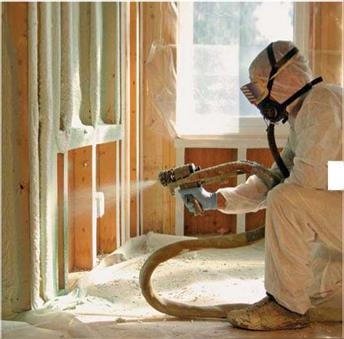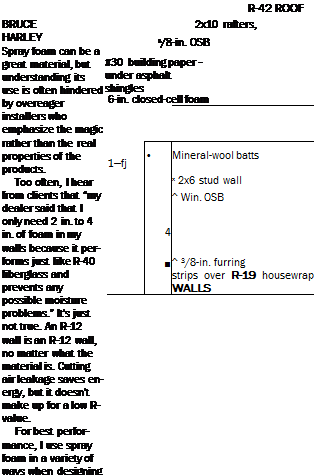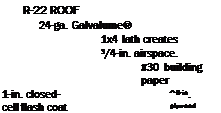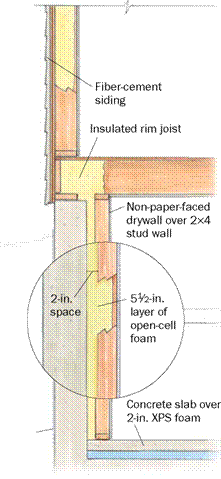The Open-Cell vs. Closed-Cell Debate
In most closed-cell foams, such as those made by Corbond®, an HFC blowing agent is captured in the foam’s cell structure. This gas has a better thermal performance than the air-filled open-cell foam and gives it a higher overall R-value. However, while HFC – blown closed-cell foam might initially have an R-value as high as R-8 per in., its R-value diminishes as the blowing agent evaporates through cell walls and is replaced by air. Closed-cell foam’s "aged" R-value is roughly R-6 per in. Some manufacturers produce water-blown closed-cell foams. These foams have the same performance properties as HFC-blown foam, but slightly lower R-values, at around R-5.5 per in.
Closed-cell foam’s greater density, 2 lb. per cu. ft. compared with open cell’s 1/2 lb. per cu. ft., also increases its R-value and offers it the rigidity that open-cell foam lacks. Tests at the National Association of Home Builders research center confirmed that closed-cell foam can actually increase the shear strength of conventionally framed walls by 30%. Closed-cell foam also has a low vapor-permeability rating (roughly 0.5 perms at a thickness of 3 in.) and is considered a class-II vapor retarder, meaning it’s semi-impermeable.

OPEN CELL
Density: Vi lb. per cu. ft. R-value: 3.5 per in.
Vapor permeability: Permeable Air barrier: Yes Blowing agent: Water
![]()


Open-cell foam, made by companies such as Icynene® and Demilec®, has a greater expansion rate than closed-cell foam. It expands 100 times its initial volume (closedcell foam expands only 30 times its initial volume), so less of the foam is needed to insulate a house.
Open cell’s one major weakness is its lower R-value, roughly R-3.5 per in. This means that when used in a 2×4 exterior wall, it will create an assembly that’s approximately only R-12, which won’t meet code in most parts of the country.
Installing Lots of Foam Isn’t as Effective as You Think
A lot of energy-conscious architects and builders shoot for the highest R-values they can possibly attain: R-40 walls and an R-60 roof. However, R-values aren’t necessarily an accurate reflection of overall thermal performance. For example, you would think that an R-40 wall full of spray foam would perform twice as well as a wall sprayed to R-20 with the same foam, but that’s not the case.
Chris Porter, the building-science and code manager for BioBased Insulation®, explains that "open-cell foam reaches a point of diminishing returns at around
5 in. That threshold is even lower for closedcell foam, which experiences diminishing returns at around 3 in. or 4 in." Those thicknesses create assemblies between R-20 and R-24, which by the numbers seem a little weak. Each additional inch of spray foam
|
|
|
|
 |
|
 |
|
|
|
|
|
|
|
|
|
|
|
|
|


 |
Consuming fossil fuels to make products intended to conserve fossil fuels makes little sense to a lot of people. All spray foams contain a certain level of petroleum in their A component and in their B component. Manufacturers such as BioBased Insulation, Demilec, and Icynene have created more environmentally benign spray-foam products by reducing the amount of petroleum used in their B component. They replace a portion of the polyol resin, which makes up 20% to 30% of the B component, with a renewable resource such as soybean or castor-bean oil. Apex even has a sucrose-based polyol. Manufacturers say that the transition to bean oil or sucrose doesn’t alter the look or the performance of open – or closed-cell foam in any way.
The amount of soybean, castor bean, or sucrose found in foam varies by manufacturer, so identifying the “greenest” foam might not be so easy. According to the U. S. Department of Agriculture, only 7% of a spray-foam product needs to be made of a renewable resource to be labeled as a biobased foam. This, of course, doesn’t factor in the petroleum fueling the crop-cultivation process.
yields little performance. In fact, while the cost of an R-40 wall is indeed double that of an R-20 wall (not factoring in the construction materials used to create deeper cavities for the extra foam), it reduces the heat flow through a wall by only an additional 2%.
For this reason, Porter says that in most parts of the country, 6 in. of foam—be it open or closed cell—is perfectly adequate.
Spray foam is priced based on board feet. Manufacturers don’t price their product. Instead, cost is determined by installers. The spray-foam market is extremely competitive, and spray-foam prices can be astonish-







Leave a reply